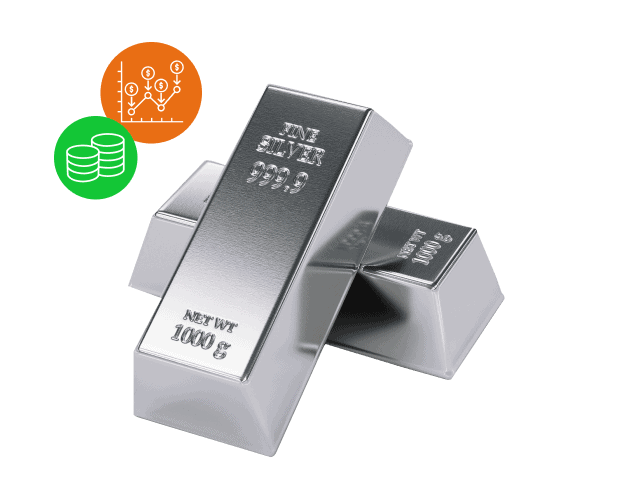Ready to take the plunge and start investing in silver? Find out more about this valuable commodity, its historical performance and how you can start investing.
There are many different ways to grow your wealth. From high-interest savings accounts to managing a portfolio of physical properties and, of course, investing in global stocks. But there is also the opportunity to invest in commodities such as gold and silver.
But is silver still an asset that could help you achieve your financial goals? Like any decision about the stock market, investing in silver stocks requires research and due diligence to ensure it aligns with your investment goals — whether they are long-term or short.
To help you make a decision on whether or not to invest your hard-earned dollars in silver, this guide will answer the most important questions.
What should you know about the silver industry in Australia?
Back in the 19th century, silver was minted and used as money for international trade, but it was phased out slowly as a currency due to its value being too high — that is, the value of the silver was worth more than the face value of the silver coin. In terms of investment, silver has largely played second fiddle to gold due to its lower price and profile by comparison, however, years such as 2020 saw it hit the headlines again.
More locally, Australia has the third-largest silver reserves in the world, only trailing behind Peru and Poland. However, despite the amount there is to mine, Australia tends to deliver only modest production levels. In 2019, for example, Australia produced 1,400 metric tons of silver, compared to Mexico, which produced 6,300 metric tons.
How have silver stocks performed historically?
The good news for investors thinking about adding silver to their portfolio is that it is a metal that is in huge demand across a variety of industries. This is because it has many useful properties — companies in shipping and transport want it for its electrical conductivity (e.g., for RFID tags), while medical companies want to leverage its antibacterial properties.
The hard figures are quite healthy for silver. In the 20-year period between 2002 and 2022, the price of an ounce of silver skyrocketed from around $US5 to $US22 (as of May 26) — nearly a 340% gain. On the ASX in particular, there have been a few times when silver suddenly broke out and its price spiked, such as in 2010–11 when it soared over 175% in a single year before crashing over 25% in a two-day period.
What should you consider when investing in silver?

It is important to recognise the marked difference between investing in gold versus investing in silver. Silver tends to be far more volatile than gold, as its value is closely tied to the industrial supply and demand for it, particularly as part of innovative technologies.
Historically, silver played a big role in the photography industry (e.g., silver-based film) but has since gone out of fashion with the rise of digital cameras. Despite this, there has been a large uptick in silver’s application for many new innovations, such as in batteries, superconductors and microcircuits.
Many electrical appliances, industrial machines and even medical devices use, and these products are in high demand in large economies such as China and other nations in the East. This makes it a desirable commodity, which can drive up the price of silver depending on market demands.
There are also many different ways to invest in silver. Like gold, you can buy physical silver coins and bars. However, if you prefer getting exposure to commodities without having to actually own the metal, then you would likely prefer a silver ETF. You can also invest in listed companies that are currently mining silver.
A couple of examples include Polymetal International Plc, a Russian-based company, that is one of the biggest silver mining companies in the world and Fortuna Silver Mines Inc, a Canadian company that mines in Latin America and West Africa.
Can investing in silver offer dividends?
Yes, there are silver companies (such as mining operations) on the stock market that can pay investors dividends. It’s up to you to do your due diligence, research their dividend payout history and decide whether or not the company will make a good addition to your portfolio.
Just a few of the silver and precious metals mining companies that may pay dividends include Fresnillo PLC, Pan American Silver Corp and Wheaton Precious Metals.
Why did silver stocks spike in 2020?
No one could have predicted that the COVID-19 pandemic would sweep the world — nor the effect it would have on the stock market. But as global disruption caused investors to leave the volatility of trading shares to the perceived “safety” of commodities such as gold, silver was on an upward trajectory. In fact, the gold-silver ratio at the peak of the COVID-19 crisis was a whopping 1:124 — the highest ratio ever.
By the middle of 2020, the price of silver was approaching the heady heights of the 2011 boom. While it eventually dipped from its initial surge, the price remained relatively steady throughout the early part of 2021. It is no wonder some experts were saying silver could potentially outshine gold.
How is the silver market performing?

After the frenzy from coronavirus came the Gamestop-induced “silver squeeze”, in which a social media push by retail investors caused silver to reach an eight-year high of nearly $29 in January 2021. However, that jump was temporary, with silver prices trending downwards throughout the remainder of the year.
In early 2022, silver prices rose once again, fuelled by market volatility stemming from the conflict in Ukraine. This price spike was not to last, however, with concerns about interest rate rises in the United States and further COVID-19 lockdowns in China halting further price recovery in Q2.
While past success is no indicator of future performance, silver may be a worthy addition to many investors’ portfolios. It always depends on your risk tolerance, the amount of research you put into silver stocks, and whether it aligns with your overall investment strategy.
Tip: Set financial goals and create a plan before you invest to help mitigate risk.
With Joe Biden as president, there are hopes of a surge in stationary batteries and electric vehicles that require silver for their production, causing increased demand for the commodity. So, too, could the creation of 5G infrastructure that requires the material. Some analysts are also predicting silver value is nearing its bottom, making it a potentially attractive investment opportunity for some.
However, at the other end of the spectrum, a World Bank Report, Commodity Markets Outlook, expects the price of silver to drop slightly by 2025 before dropping even further at the end of the decade. And some analysts point to a lack of physical demand, growing US Treasury yields and the continued improvement of the US dollar as bad signs for the value of silver in the coming months.
Continue building your knowledge with the eToro Academy.
FAQs
- In what ways can you invest in silver?
-
You can invest in both physical and non-physical silver assets, including silver bullion and coins, shares in silver mining company stocks and silver ETFs.
- Why is silver a volatile commodity?
-
The price of silver is not only driven by speculation, but by supply and demand. As it has lower market liquidity compared to larger commodities such as gold, its price is more likely to fluctuate.
- What makes silver a good investment?
-
That depends on the individual and whether it is appropriate for your investment portfolio. However, many investors appreciate that silver has an intrinsic value and is, therefore, traditionally steady in the face of economic and political disruption, as well as other external factors such as inflation.
This information is for educational purposes only and should not be taken as investment advice, personal recommendation, or an offer of, or solicitation to, buy or sell any financial instruments.
This material has been prepared without regard to any particular investment objectives or financial situation and has not been prepared in accordance with the legal and regulatory requirements to promote independent research. Not all of the financial instruments and services referred to are offered by eToro and any references to past performance of a financial instrument, index, or a packaged investment product are not, and should not be taken as, a reliable indicator of future results.
eToro makes no representation and assumes no liability as to the accuracy or completeness of the content of this guide. Make sure you understand the risks involved in trading before committing any capital. Never risk more than you are prepared to lose.


